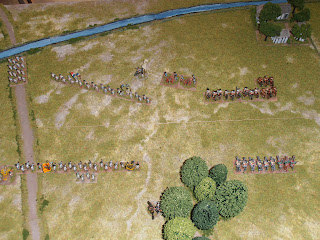4. Battle
of Höchstädt, 1703.
This is the second re-fight of the Battle of
Höchstädt, 1703, the first played 2 ½ years ago used DBA-HX 2.2. This re-fight
will use the revised 3.0. For the original game fought in 2012 readers can follow the enclosed links:.
The numbers of elements per side would not change for
this re-fight, however, adjustments were made to the composition of troops; the
addition of conscript and skirmisher types. Because distances have changed, it
was decided to play the game two boards; the first is the engagement between D’Usson and
Count Styrum and the second the arrival of the French-Bavarian army east of the
Nebel River.
French-Bavarian
Marshal Villars (CinC) 16 elements (BP = 4.0)
1 x Cuirassier, 4 x Cavalry, 6 x Line Infantry, 4 x Conscript, 1 x Light Artillery
The Elector of Bavaria 12 elements (BP = 3.0)
2 x Cuirassier, 2 x Cavalry, 4 x Line Infantry, 3 x
Conscript, 1 x Light Artillery
D’Usson at Höchstädt 8 elements (BP = 2.0)
2 x Cavalry, 3 x Line Infantry, 2 x Conscript, 1 x Light
Artillery
Imperial-Prussian
Marshal Styrum (CinC) 12 elements (BP = 3.0)
2 x Cuirassier, 2 x Cavalry, 5 x Line Infantry, 2 x
Conscript, 1 x Light Artillery
Prince Anhalt-Dessau 12 elements (BP = 3.0)
2 x Cuirassier, 2 x Cavalry, 5 x Line Infantry, 2 x Conscript,
1 x Light Artillery
Höchstädt.
D’Usson moved
out of Höchstädt on the morning of the 20th. Forming his into line,
he would await for Villars attack on the Imperial camp. The sound of the guns
would be the signal to advance and catch the Austrians in the rear.
By 8.00 am, the
sound of marching troops supplanted the expected cannonade and worse, the flags
were of Imperial make. D’Usson quickly surmised Villars was delayed and that he
would be facing the full brunt of Styrum’s force. With little opportunity to
re-deploy his troops D’Usson held his ground.
Crossing the
stream, the Austrians encountered a brisk fusillade from the French side. By 9.30,
D’Usson could no longer stem the advance of the Imperial troops and decided to
withdraw his demoralized command to Höchstädt hoping the sound of battle would
hasten Villars to his aid.
Styrum
undeterred by the small losses (1 Cv) would continue pursuit with the Prince v.
Anhalt-Dessau in support. Past midday and deploying the Imperial troops before
Höchstädt, Styrum receives alarming news that large French forces are
approaching the camp from the east. Realizing D’Usson was a mere diversion,
orders are given to hasten back to camp and prepare to fight a second battle.
Villars and the Elector.
Hearing of the
French approach to the rear, the Prince v. Anhalt-Dessau was first to redeploy
and form the left wing of the Allied army while Styrum would form on the open
space between the Prussians and the Danube River. By 10.00 am, the second
battle of the day was well under way.
By 10.00 am, it
became clear that the French were driving the Allied army away from the Danube
and toward the Goldberg mountains. The road to Nordlingen was already choked
with baggage and detachments fleeing from the camp, so time would need to gain
by making a slow and steady retreat.
The Elector of
Bavaria, closest to the Nordlingen road was “asked” to press his attack and cut
off the Allied army’s exit. Having crossed the Nebelbach, this he proceeded to
do. Unfortunately, the Prussians had differing opinion about this and delivered
an intense fusillade on the cornflower blue line.
An hour later
(11.00 am), having committed his entire command, the Elector could make no
impression on the Prussians. The decisive blow would have to be delivered by
Villars himself.
Villars was
doing precisely that and before noontime the coordination of cavalry attacks
against the Imperial flank and a steady advance with volley fire was gradually
weakening Styrum’s command. Before 12.00, the Austrians began to flee toward
the road to Nordlingen. It would now be up to the Prussians to hold the door
open long enough to save the army from disaster.
Through a
concerted effort by Prussian cavalry the Bavarian Horse were beaten off leaving
a sole Bavarian Cuirassier unit to hold the flank. The Bavarian foot seeing the
Austrians in flight were frustrated in their effort to break the Prussians.
Their hopes died when loud cheers could be heard on the right flank signalling
the demise of the Bavarian Cuirassier unit. With all the Bavarian cavalry gone
the Elector would be hard pressed to keep his troops in position.
Cheers,










Geen opmerkingen:
Een reactie posten